|
|
StanhopeaFamily: Orchidaceae.
|
|
|
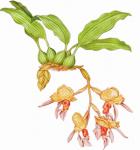 |
Genus of about 30 species of evergreen, epiphytic orchids from moist forest, in Mexico and Central and South America. The conical, ribbed pseudobulbs each bear a single, large, semi-rigid, folded, elliptic to oblong-lance-shaped leaf. Pendent racemes of 2-10 fragrant, short-lived (2-3 days) flowers arise from the bases of the pseudobulbs. |
|
| Growing conditions |
Watering and misting |
Propagation |
| Cool- to Intermediate-growing orchids. Grow epiphytically on bark, or in epiphytic orchid potting mix in moss-lined, slatted baskets, to allow the pendent racemes to spread freely downward through the potting mix and out the bottom of the basket. Provide high humidity and bright filtered light in winter. |
Water and mist freely, when in growth. Water sparingly when inactive (usually in early summer). |
Divide the plant or remove backbulbs. |
|
Stanhopea Assidensis |
|
|
One of the more striking of this genus. The parents are found throughout Central America and northern South America. They are a favorite of many collectors. Although flowers are short-lived, the plant flowers almost continuously from mid-summer through fall. This is a primary hybrid where the S. tigrina parent dominates in color and pattern. Intermediate temperature with moderate light. Fragrant! |
 |
|
Stanhopea embrei |
|
|
This stanhopea blooms while still a small plant (2-3 bulbs). Typical of most, blooms are short-lived, but blooms throughout summer into late fall. Creamy colored flowers are highly fragrant. Likes intermediate temperature, moderate light, and lots of water during active growth. |
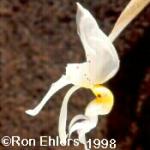 |
|
Stanhopea grandiflora |
|
|
This stanhopea blooms white with some yellow/orange in the throat at the base of the column. Makes good sized, fragrant flowers. Typical of most, blooms are short-lived, but blooms throughout summer into late fall. Likes intermediate temperature, moderate light, and lots of water during active growth. |
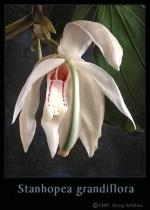 |
|
Stanhopea oculata Lindl. |
|
|
|
 |
|
Stanhopea reichenbachiana |
|
|
|
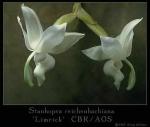 |
|
Stanhopea tigrina Batem. |
|
|
One of the more spectacular New World species - a parent of S. Assidensis. Large, fragrant flowers lasts for several days, but continues to flower through fall. Likes intermediate temperature, moderate light, and lots of water during active growth. |
 |
|
Stanhopea Wardii |
|
|
Large intermediate-growing epiphyte with large broad leaves on a long stalk. Tightly clustered conical pseudobulbs about 1.5" tall; each bears a single glossy dark-green leaf with a narrow 4-5" base that looks like a stalk; the main part of the leaf is up to 12" long and 5" wide and is subtly plicate; extremely vigorous roots totally pack the medium; flower spikes arise basally as new growth matures and are sharply pendant; each spike bears several large yellow fragrant flowers that are elaborately shaped and short lived. |
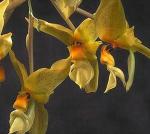 |
User-submitted additions and corrections:
pmrorchideas (Paul)
United States
17th Sep 2009
|
This genus has become my passion. In our area, between San Francisco and San Jose, California, many of these can be grown outdoors, and as long as one can protect them from high winds, and the rare temperature drops below zero Celsius, they tend to do well. Certain of them need to be kept drier than our climate offers during the winter, so for species like S. jenishiana, it helps to put them under cover from the rain when it is quite cool and the plants are not growing much. In a short note, one shouldn't generalize to the whole genus, but many if not all do well in our climate if the roots are kept moist, the plants protected from sunburning, certain species are given a nearly dry rest in the winter, and one follows the usual guidelines for the genus. Some species do require a heated greenhouse with more humidity than others, so check out the natural conditions for each species you wish to acquire before choosing. |
|
These materials are freely provided for instructional and educational purposes. Any duplication or publication of text or images herein for commercial gain without explicit written permission of the owner or photographer constitutes breach of trust and violation of copyright.
Copyright © Galka Okhapkina 1998-2026








